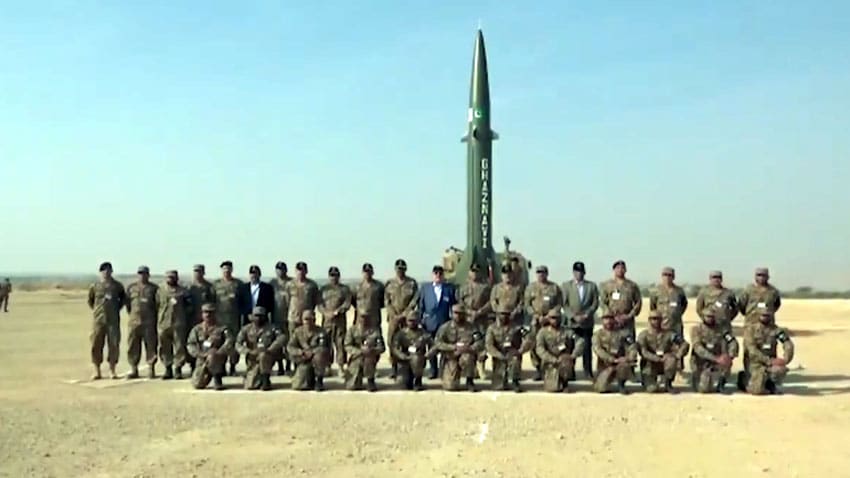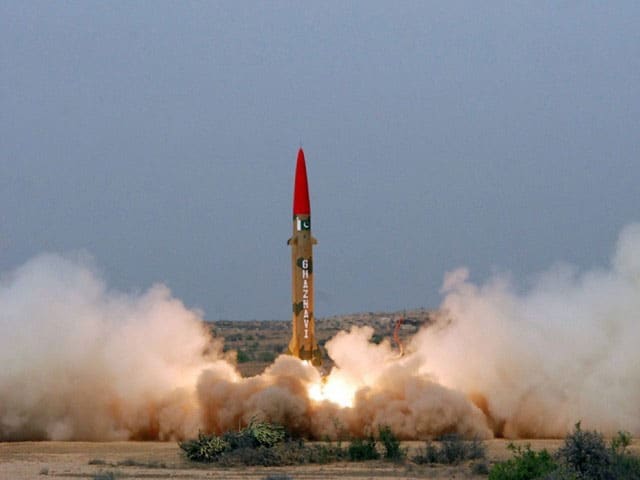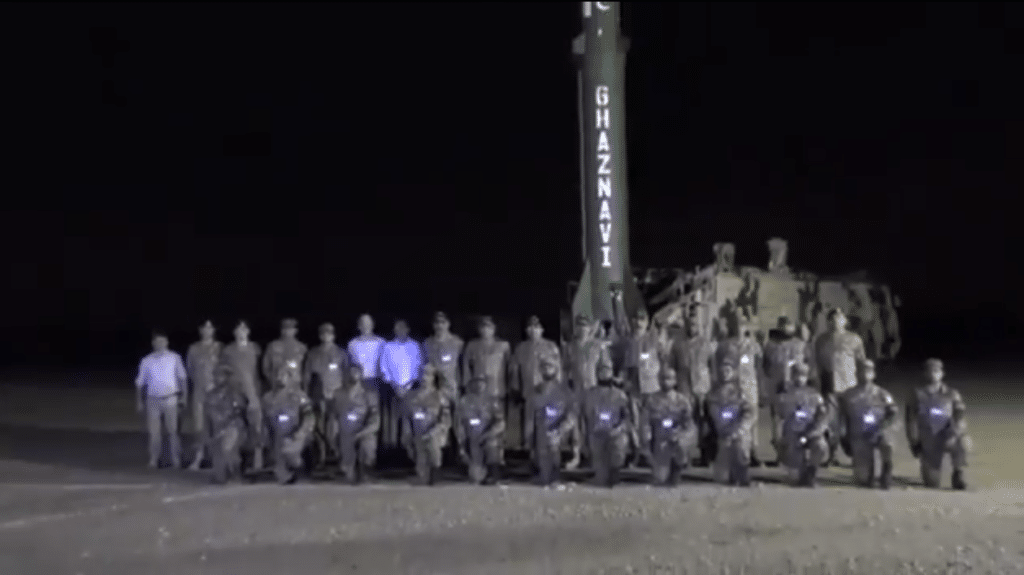The Ghaznavi (Hatf 3) is a Pakistani short-range ballistic missile. It has a range of 300 km and is directly derived from China’s DF-11 short-range ballistic missile.1 Pakistan received significant technical assistance and over 30 DF-11 missiles from China through the early 1990s.2
Ghaznavi (Hatf 3) at a Glance
- Originated from
- Pakistan
- Possessed by
- Pakistan
- Class
- Short-Range Ballistic Missile (SRBM)
- Basing
- Road-mobile
- Length
- 8.5 m
- Diameter
- 0.8 m
- Launch weight
- 4,650 kg
- Payload
- Single warhead, 700 kg
- Warhead
- HE, submunitions, 12 – 20 kT nuclear
- Propulsion
- Single-stage solid propellant
- Range
- 300 km
- Status
- Operational
- In service
- 2004 – Present

Missile crew posing in front of a Ghaznavi before an January 2020 test launch. Photo: Pakistan media 
A Ghaznavi test launch. Photo: ISPR Pakistan 
Scientists posing in front of Ghaznavi missile before an August 2019 test launch. Photo: Pakistan media
Ghaznavi Development
Pakistan originally began developing the Ghaznavi/Hatf-3 in 1987, but terminated the program after its purchases of Chinese M-11 (DF-11) missiles in the early 1990s. These were later renamed the Ghaznavi missile.3 China first flight tested the M-11 in 1990, and Pakistan conducted its first known Ghaznavi test in May 2002. The system became operational in 2004.4 Subsequent flight tests took place in June and December of 2006, February 2008, and May 2010.
Specifications
The Ghaznavi visually resembles the DF-11, measuring roughly 8.5 m long, 0.8 m in diameter, and weighing 4,650 kg at launch It can carry a single warhead of up to 700 kg to a range of 290 – 300 km.5 It is a single-stage, solid propelled missile, and is launched from a wheeled, four-axle transporter-erector-launcher (TEL).
The missile can load a variety of conventional unitary, submunition, and nuclear payloads. Its nuclear-equipped variant likely features a single, 5 – 12 kt warhead. Ghaznavi’s inertial guidance system provides an estimated accuracy of 250 m circular error probable (CEP). If equipped with terminal guidance, however, its accuracy could improve to 50 m CEP. 6
Service History
Pakistan ceased Ghaznavi production in April 2007, with between 30 and 50 missiles in service as of 2007.7 By 2019, Pakistan reportedly operated 30 Ghaznavi launchers, with roughly 16 configured with nuclear warheads.8
Footnotes
- Vipin Narang, “Pride and Prejudice and Prithvis: Strategic Weapons Behavior in South Asia,” in Inside Nuclear South Asia, ed. Scott D. Sagan (Stanford: Stanford University Press, 2009).
- Timothy V. McCarthy, A Chronology of PRC Missile Trade and Developments, (Monterey, CA: Monterey Institute of International Studies, February 12, 1992), https://apps.dtic.mil/sti/pdfs/ADA338725.pdf; Hans M. Kristensen & Robert S. Norris, Pakistani nuclear forces, 2015, Bulletin of the Atomic Scientists, 71:6, 62.
- Hans M. Kristensen & Robert S. Norris, Pakistani nuclear forces, 2015, Bulletin of the Atomic Scientists, 71:6, 62; “Hatf 3 (Ghaznavi), in IHS Jane’s Weapons: Strategic 2015-2016, ed. James C. O’Halloran (United Kingdom: IHS, 2015), 72-73.
- Jonathan McLaughlin, “Pakistani Missile Update,” Wisconsin Project on Nuclear Arms Control, February 2016, http://www.wisconsinproject.org/countries/pakistan/PakistanMissileUpdate-2016.html.
- Foreign Missile Developments and the Ballistic Missile Threat Through 2015, (Washington, DC: National Intelligence Council, December 2001),https://www.dni.gov/files/documents/missilethreat_2001.pdf.
- “Hatf 3 (Ghaznavi), in IHS Jane’s Weapons: Strategic 2015-2016, ed. James C. O’Halloran (United Kingdom: IHS, 2015), 72-73.
- “Hatf 3 (Ghaznavi), in IHS Jane’s Weapons: Strategic 2015-2016, ed. James C. O’Halloran (United Kingdom: IHS, 2015), 72-73.
- The Military Balance, (London: International Institute for Strategic Studies, 2019), p. 297; Hans Kristensen, Robert S. Norris, and Julia Diamond, “Pakistani nuclear forces, 2018,” Bulletin of the Atomic Scientists 74, No. 5 (2018), pp. 348 – 358.